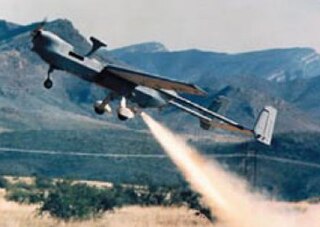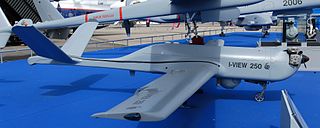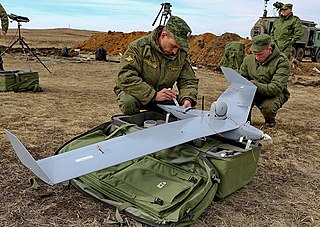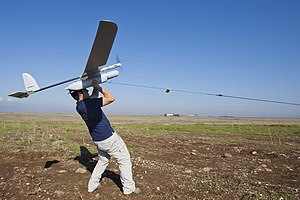
The IAI RQ-5 Hunter unmanned aerial vehicle (UAV) was originally intended to serve as the United States Army's Short Range UAV system for division and corps commanders. It took off and landed on runways. It used a gimbaled EO/IR sensor to relay its video in real time via a second airborne Hunter over a C-band line-of-sight data link. The RQ-5 is based on the Hunter UAV that was developed by Israel Aerospace Industries.

The AAI RQ-7 Shadow is an American unmanned aerial vehicle (UAV) used by the United States Army, Australian Army, Swedish Army, Turkish Air Force and Italian Army for reconnaissance, surveillance, target acquisition and battle damage assessment. Launched from a trailer-mounted pneumatic catapult, it is recovered with the aid of arresting gear similar to jets on an aircraft carrier. Its gimbal-mounted, digitally stabilized, liquid nitrogen-cooled electro-optical/infrared (EO/IR) camera relays video in real time via a C-band line-of-sight data link to the ground control station (GCS).

A miniature UAV, small UAV (SUAV), or drone is an unmanned aerial vehicle small enough to be man-portable. Smallest UAVs are called micro air vehicle.

RANGER is a tactical UAV system (TUAV) built as a Swiss-Israeli joint venture between Swiss aerospace enterprise RUAG Aviation and Israeli aerospace company Israel Aerospace Industries. Its design and some of its technology is based on the Scout UAV system by Israel Aerospace Industries.

The Elbit Hermes 450 is an Israeli medium-sized multi-payload unmanned aerial vehicle (UAV) designed for tactical long endurance missions. It has an endurance of over 20 hours, with a primary mission of reconnaissance, surveillance and communications relay. Payload options include electro-optical/infrared sensors, communications and electronic intelligence, synthetic-aperture radar/ground-moving target indication, electronic warfare, and hyperspectral sensors.

Aeronautics Ltd. is an Israeli company specializing in the manufacturing of Unmanned Aerial Systems for military uses. Since its establishment in 1997, the company has sold its products to more than 20 defense, military and homeland security customers in 15 countries. Its headquarters are in Yavne, Israel.

The Northrop Grumman Bat is a medium-altitude unmanned air vehicle originally developed for use by the United States Armed Forces. Designed primarily as an intelligence "ISR" gathering tool, the Bat features 30 lb (14 kg) payload capacity that is unmatched in a 10 ft (3.0 m) wing span.
The S-TEC Sentry is a reconnaissance unmanned aerial vehicle (UAV), developed in the United States in the 1980s. Built by S-TEC systems of Texas, it is a battlefield mini-UAV in roughly the same class as the BAI Dragon drone. In fact, the Sentry looks something like an Exdrone with a twin-boom raised tail. It is built of carbon composition and Kevlar, and powered by a 19.5 kW (26 hp) piston engine in a tractor configuration.

The IAI Searcher is a reconnaissance UAV developed in Israel in the 1980s. In the following decade, it replaced the IMI Mastiff and IAI Scout UAVs then in service with the Israeli Army.

The IAI I-View is a small reconnaissance unmanned aerial vehicle developed in Israel in the early 21st century. Like other UAVs produced by IAI, it has fixed landing gear and an 18.6 kW (25 hp) piston engine. The Eye-View is also being promoted in civilian markets for forest fire warning, and in this form is appropriately known as the FireBird.

The Elbit Systems Hermes 90 is an unmanned aerial vehicle (UAV) designed for tactical short-range missions using a heavy-fuel motor.
Kapothaka was a technology demonstrator mini-UAV for reconnaissance. The Kapothaka which means “dove” is believed to be a predecessor of Nishant UAV system.

IAI Bird-Eye is a family of mini-UAVs developed by Israel Aerospace Industries (IAI) Malat division. Designed for military and paramilitary intelligence, surveillance and reconnaissance missions.

The Elbit Systems Hermes 900 Kochav ("Star") is an Israeli medium-size, multi-payload, medium-altitude long-endurance unmanned aerial vehicle (UAV) designed for tactical missions. It is a successor to the Hermes 450 series of drones, one of the most widely used military drones in the world.

The Boeing Insitu RQ-21 Blackjack, company name Integrator, is an American unmanned air vehicle designed and built by Boeing Insitu to meet a United States Navy requirement for a small tactical unmanned air system (STUAS). It is a twin-boom, single-engine monoplane, designed as a supplement to the Boeing Scan Eagle. The Integrator weighs 61 kg (134 lb) and uses the same launcher and recovery system as the Scan Eagle.

TAI Gözcü is a radio-controlled short-range tactical drone. Designed, developed and built by Turkish Aerospace Industries (TAI), the unmanned aerial vehicle (UAV) is in use by the Turkish Armed Forces for intelligence, surveillance, target acquisition and reconnaissance purposes. Gözcü is the Turkish word for observer.

The Wing Loong-10 is a series of unmanned aerial vehicles of the High-Altitude Long Endurance (HALE) type, featuring some stealth characteristics. As of 2017, it is being developed by the Chengdu Aircraft Industry Group for reconnaissance and precision strike missions.

The TAI Aksungur is an unmanned combat aerial vehicle (UCAV) built by Turkish Aerospace Industries (TAI) for the Turkish Armed Forces. Using existing technology from the TAI Anka series of drones, it is the manufacturer's largest drone with payload capacity for mission-specific equipment. It is intended to be used for long-term surveillance, signals intelligence, maritime patrol missions, or as an unmanned combat aerial vehicle. TAI planned to integrate weapon packages and put the Aksungur into production in early 2020. The first unit was delivered to the Turkish Naval Forces on 20 October 2021.

V-BAT is a vertical take-off and landing (VTOL) reconnaissance unmanned aerial vehicle originally developed by Martin UAV, now Shield AI.





















